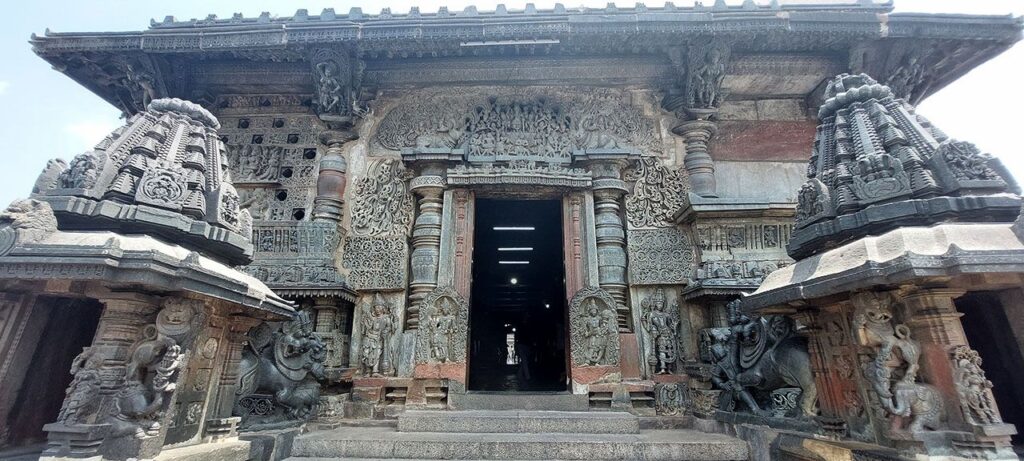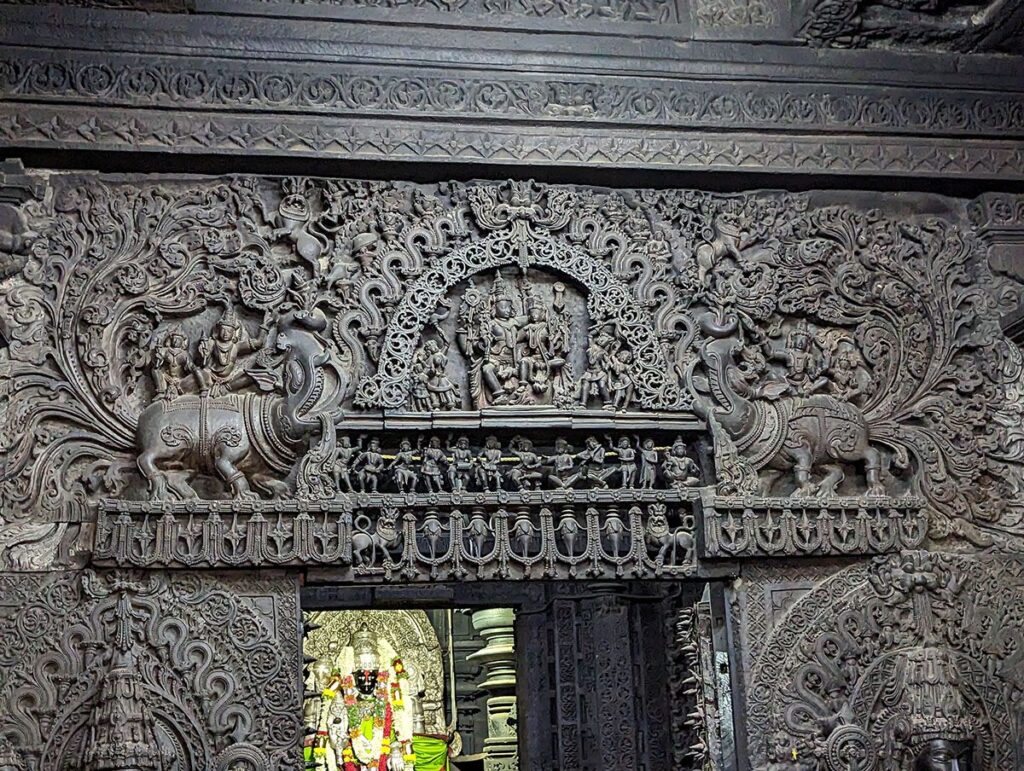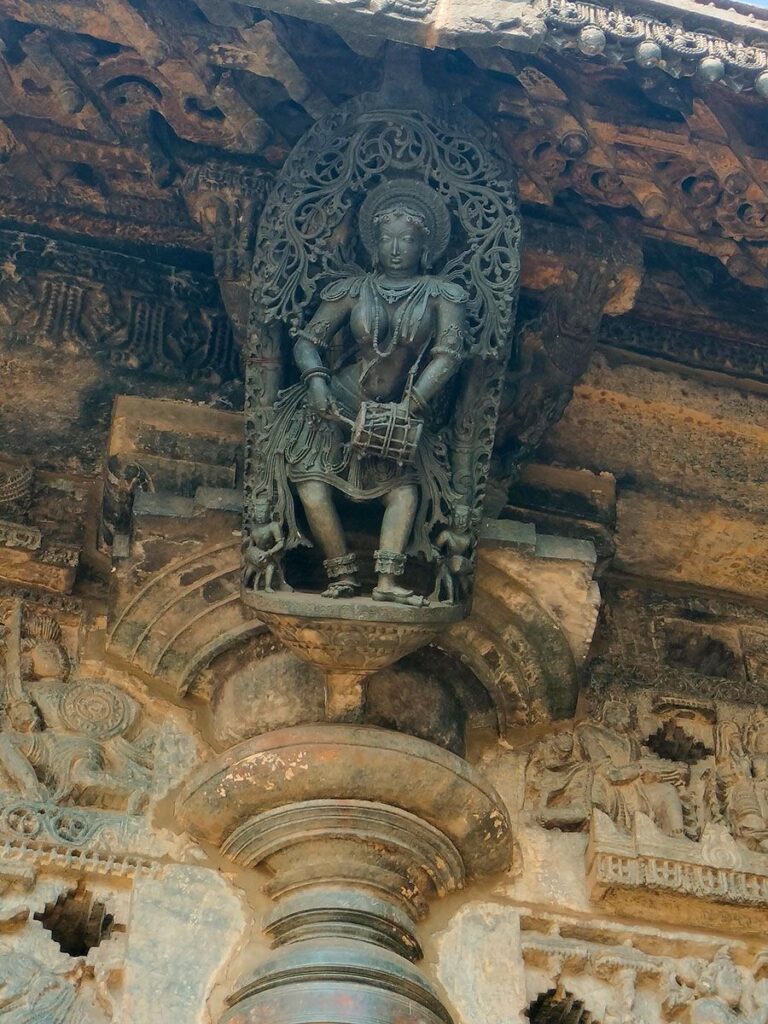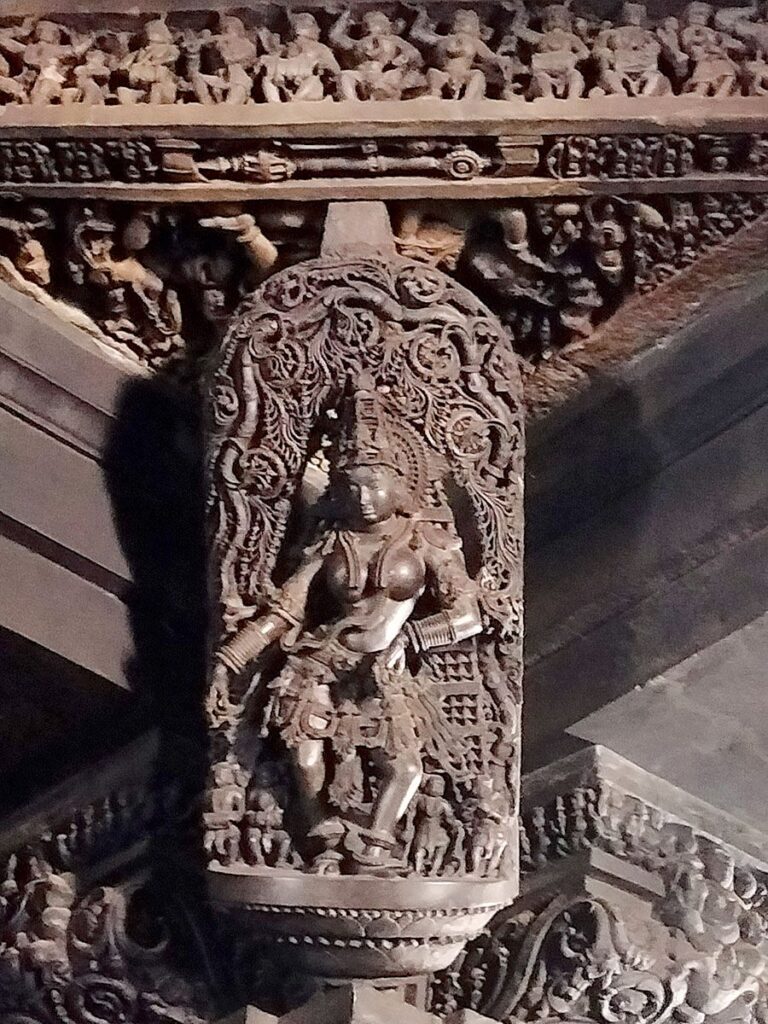Chennakesava Temple Belur: Finest Hoysala Architecture
The Chennakesava Temple, also referred to as Keshava, Kesava or Vijayanarayana Temple, is a 12th-century Hindu temple located in Belur, Hassan district of Karnataka state, India. It is considered to be one of the finest examples of Hoysala architecture.

Contents
- 1 Chennakesava Temple Belur History:
- 2 Significance of Chennakesava Temple:
- 3 Legend of Chennakesava Temple:
- 4 Myths & Beliefs of Chennakesava Temple:
- 5 Chennakesava Temple Architecture:
- 6 Chennakesava Temple Timing and Rituals:
- 7 Interesting Facts about Chennakesava Temple:
- 8 Places to visit near Chennakesava Temple Belur:
- 9 FAQ:
- 10 How to reach Chennakesava Temple Belur:
- 11 Google Maps:
Chennakesava Temple Belur History:
- Early 12th Century Origins: The Chennakesava Temple, also referred to as the Vijayanarayana Temple, was commissioned by King Vishnuvardhana of the Hoysala Empire in 1117 CE.
- Commemorating Victory: The temple’s construction is believed to be linked to King Vishnuvardhana’s military victories, particularly against the Cholas.
- A Collaborative Effort: The temple was built over three generations and took a total of 103 years to complete. Master craftsmen Dasoja and Chavana, a father-son duo, are credited with its exquisite architecture.
- Hoysala Architectural Marvel: The Chennakesava Temple is a prime example of Hoysala architecture, renowned for its intricate carvings, soapstone construction, and meticulous design.
- Enduring Legacy: Despite facing damage and renovations throughout history, the temple remains a UNESCO World Heritage Site and a popular tourist destination.
Read More>> Shivoham Shiva Temple: 65 Foot Tall Statue of Lord Shiva

Significance of Chennakesava Temple:
- Historical Landmark: Built in the early 12th century by the Hoysala Empire, the temple stands as a testament to their architectural prowess and artistic vision. It reflects a period of prosperity and cultural development in the region.
- Architectural Marvel: The Chennakesava Temple is a prime example of Hoysala architecture. This architectural style is renowned for its intricate soapstone carvings, detailed friezes depicting mythological scenes, and meticulously designed temple layout. The temple itself is considered a masterpiece, showcasing the creativity and skill of Hoysala artisans.
- Religious Significance: Dedicated to Vishnu, one of the principal Hindu deities, the temple is an active place of worship for Hindus. The presence of shrines dedicated to other deities like Shiva and Shakti reflects the temple’s inclusivity and its connection to various aspects of Hinduism.
- Symbol of Victory: The temple’s construction is believed to be linked to King Vishnuvardhana’s military victories, particularly against the Cholas. It served as a monument to his achievements and a symbol of the Hoysala dynasty’s power.
- UNESCO World Heritage Site: In recognition of its exceptional cultural and historical value, the Chennakesava Temple, along with other Hoysala era temples, was designated a UNESCO World Heritage Site in 2023. This inscription ensures its preservation for future generations.
- Tourist Destination: The exquisite carvings, intricate details, and historical significance make the Chennakesava Temple a popular tourist destination. It attracts visitors interested in Indian history, art, and architecture.
Read More>> 7th Century Virupaksha Temple Hampi

Legend of Chennakesava Temple:
The Dream and the Disappearing Sandals:
- King Vishnuvardhana’s Vision: Legend says King Vishnuvardhana, the Hoysala king who commissioned the temple, dreamt of Lord Vishnu (also known as Keshava) one night. In the dream, Vishnu instructed him to build a temple in his honor.
- A Temple Built, But Something Lacking: Following the divine vision, King Vishnuvardhana embarked on constructing a magnificent temple dedicated to Chennakesava, meaning “handsome Keshava.” The temple was built with utmost devotion and grandeur.
- The Mystery of the Vanishing Sandals: However, a peculiar phenomenon began to occur. Every time a new pair of sandals was offered at the deity’s feet, they would mysteriously disappear. This continued to happen for quite some time.
- A Longing for His Consort: The legend suggests that unknowingly, when Vishnuvardhana built the temple in Belur, he separated the Lord from his consort, typically depicted as Lakshmi, who resided in a distant place. The disappearing sandals symbolized the Lord’s desire to visit his consort, and the distance between the two temples.
- A Tradition of Cobblers: Touched by this legend, the local cobbler community stepped forward. They took it upon themselves to offer the temple a fresh pair of sandals every day, hoping to ease the Lord’s journey to see his consort. This tradition is said to continue even today.
Significance of the Legend:
This legend adds a layer of charm and mystery to the Chennakesava Temple. It speaks to the enduring devotion of devotees and the belief in the divine connection between the temple and the Lord. It’s a reminder of the importance of balance and the power of faith to bridge distances.
Read More>> Murudeshwar Temple Karnataka: India’s 2nd Massive Shiva Statue

Myths & Beliefs of Chennakesava Temple:
- The Disappearing Sandals and the Longing Vishnu:
- This is a popular legend associated with the temple. It narrates King Vishnuvardhana’s dream of Lord Vishnu instructing him to build a temple. The king devoted himself to constructing a magnificent edifice, Chennakesava Temple. However, a strange occurrence began. Every time a new pair of sandals was offered at the deity’s feet, they would mysteriously vanish overnight.
- The legend takes a turn towards the divine. It suggests that while building the temple, the king unknowingly separated Lord Vishnu from his consort, Lakshmi, who resided in a distant location. The disappearing sandals symbolized the Lord’s longing to visit his consort, highlighting the distance between their abodes.
- Touched by this tale, the local cobbler community stepped forward. They took it upon themselves to offer the temple a fresh pair of sandals every day, hoping to ease the Lord’s journey to reunite with his consort. This tradition is said to continue even today.
- Significance: This legend adds a layer of charm and mystery to the temple. It speaks to the enduring devotion of devotees, the belief in the divine connection between the temple and the deity, and the importance of balance.
- The Temple and the Hoysala Legacy:
- This belief isn’t exactly a myth, but a historical association woven into the temple’s origin story. The Chennakesava Temple is considered a prime example of Hoysala architecture. Built in the 12th century by King Vishnuvardhana, the temple reflects the artistic prowess and cultural achievements of the Hoysala Empire during its reign.
- The intricate carvings, meticulous design, and soapstone construction are all hallmarks of the Hoysala architectural style. The Chennakesava Temple stands as a testament to the era’s prosperity and artistic development, showcasing the skill and creativity of Hoysala artisans.
- Significance: This belief highlights the historical significance of the temple. It’s a window into the cultural heritage of the Hoysala dynasty and a reminder of their architectural legacy.
Read More>> Sri Banashankari Temple Bengaluru

Chennakesava Temple Architecture:
Building Material:
- Soapstone: The temple is primarily constructed using soapstone, also known as chloritic schist. This soft stone allowed artisans to carve intricate details with remarkable precision. Over time, the soapstone hardens, ensuring the temple’s durability.
Temple Layout:
- Hoysala Plan: The Chennakesava Temple follows a typical Hoysala plan. It features a central sanctum (garbhagriha) housing the main deity, Chennakesava (a form of Vishnu). The sanctum is surrounded by an ambulatory passage (mantapa) with a closed mandapa (hall) in front.
- Star-Shaped Base: The central sanctum sits on a unique star-shaped platform, adding a distinctive element to the temple’s design.
Exquisite Carvings:
- Soapstone’s Canvas: The beauty of the Chennakesava Temple lies in its extensive and intricate carvings. The soapstone provided the perfect canvas for Hoysala artisans to showcase their skill.
- Mythological Tales: The temple walls are adorned with friezes depicting scenes from Hindu mythology, including stories from the Ramayana, Mahabharata, and Puranas. These carvings offer a glimpse into the religious beliefs and practices of the Hoysala period.
- Flourishing Flora and Fauna: The carvings extend beyond mythological themes. The temple is embellished with intricate depictions of floral designs, geometric patterns, and various animals, showcasing the artists’ remarkable attention to detail.
Decorative Elements:
- Dravida Vimana: The temple features a towering Vimana (tower) above the sanctum, built in the Dravida architectural style. This tower is adorned with intricate carvings and sculptures, adding to the temple’s grandeur.
- Hoysala Pillars: The temple is known for its numerous exquisitely carved pillars. These pillars showcase various decorative motifs, including fluted designs, lathe-turned patterns, and intricate scrollwork. Some notable pillars include the “Madanikas” (celestial maidens) pillars with their graceful poses.
- Elaborate Entrances: The temple has intricately carved gateways (gopurams) marking the entrances. While the outer gopurams are smaller, they still reflect the detailed artistry of the Hoysala style.
Read More>> Horanadu Annapoorneshwari Temple
Chennakesava Temple Timing and Rituals:
Temple Timings:
- General Timings:
- Mornings: 6:00 AM to 12:30 PM
- Evenings: 5:00 PM to 8:30 PM
It’s advisable to check with the temple authorities for any specific timings during festivals or special poojas.
Important Note: These timings are based on information available online and might change. It’s always best to confirm the timings with official sources or local contacts before your visit.
Rituals at the Temple:
The Chennakesava Temple follows traditional Hindu rituals associated with Vishnu worship. Here’s a glimpse into some of them:
- Mangala Aarti: This is a prayer ceremony performed at sunrise to greet the deity.
- Abhisheka: This ritual involves bathing the idol of Lord Vishnu with sacred substances like milk, curd, and panchamrita (a mixture of five nectars). This is usually performed during special occasions or on a daily basis depending on the temple’s practices.
- Aarti: Aarti is a form of worship involving lighting lamps or offering flames in front of the deity, accompanied by prayers and chants. Aarti is performed at various times throughout the day.
- Pooja: This is a general term for various prayer rituals involving offerings like flowers, incense, and food to the deity. Different pujas are performed based on the occasion and specific prayers.
- Sevas (Services): Devotees can participate in various sevas offered by the temple, such as sponsoring lamps, performing special poojas, or offering prasad (blessed food).
Festivals:
The Chennakesava Temple comes alive during Hindu festivals throughout the year. Here are a couple of noteworthy ones:
- Vaikuntha Ekadashi: This festival falls in the Hindu month of Dhanurmasa (usually December or January) and is dedicated to Lord Vishnu. Special poojas and rituals are observed at the temple during this time.
- Hoysala Mahotsava: This annual festival, typically held in November or December, celebrates the rich heritage of the Hoysala dynasty. The temple is decorated with lights and flowers, and cultural programs showcasing music and dance are organized.
Read More>> Kabbalamma Temple Kanakapura
Interesting Facts about Chennakesava Temple:
- A Collaborative Effort: The temple wasn’t built by a single ruler but across three generations. King Vishnuvardhana initiated the project in 1117 CE, and it was finally completed 103 years later during the reign of his grandson, Veeranarayana.
- Gravity Pillar Mystery: The temple complex has a fascinating structure called the “Mantapa with a Hoysala Pillar.” This pillar, also known as the “Lamp Post” or “Gravity Pillar,” stands tall in the courtyard without any visible support at its base. Legend says it’s balanced on a single point of contact, defying gravity. While the exact construction technique remains a mystery, it’s believed that the pillar’s weight is cleverly distributed throughout its base, creating an illusion of defying gravity.
- Disappearing Sandals Legend: A popular legend associated with the temple is the tale of the disappearing sandals. It’s said that every night, a new pair of sandals offered to the deity would vanish. The legend suggests this symbolizes Lord Vishnu’s longing to reunite with his consort, Lakshmi, who resided in a distant temple. Touched by this story, the local cobbler community stepped forward to offer the temple fresh sandals every day, a tradition that supposedly continues even today.
- Not Just One Chennakesava: While the main deity is Chennakesava (handsome Keshava), the temple complex actually houses three separate shrines. The central sanctum enshrines Chennakesava, while the northern and southern sanctums are dedicated to Janardhana and Venugopala, respectively, all forms of Lord Vishnu.
- Architectural Marvels Beyond the Temple: The Chennakesava Temple is the centerpiece of the complex, but there’s more to explore. The surrounding courtyard is adorned with exquisite Hoysala architecture, including intricately carved panels, friezes depicting mythological scenes, and beautifully designed smaller shrines.
- A Hidden Message? Some believe the intricate carvings on the temple walls might hold hidden messages or astronomical codes. Researchers continue to study these carvings, hoping to unravel their deeper meaning and symbolism.
- Musical Pillars: While not proven, some claim that specific pillars within the temple, when tapped, produce musical notes. This adds to the intrigue surrounding the temple’s construction and craftsmanship.
Read More>> Karya Siddhi Anjaneya Temple Girinagar Bangalore
Places to visit near Chennakesava Temple Belur:
- Halebidu: Just around 16 kilometers away from Belur, Halebidu is renowned for its Hoysala architecture as well. The Hoysaleswara Temple in Halebidu is a must-visit, known for its intricate carvings and sculptures.
- Shravanabelagola: Located about 80 kilometers from Belur, Shravanabelagola is a significant Jain pilgrimage site. It is famous for the colossal monolithic statue of Lord Gomateshwara, also known as Bahubali, which stands atop the Vindhyagiri Hill.
- Yagachi Dam: Situated around 3 kilometers away from Belur, Yagachi Dam is a popular picnic spot. The dam offers serene surroundings and beautiful views, making it an ideal place to relax and enjoy some time amidst nature.
- Kedareshwara Temple: This temple is located near Halebidu and is part of the Hoysala Temple Complex. It features remarkable architecture and intricate carvings, similar to those found in Belur and Halebidu temples.
- Belavadi: About 30 kilometers from Belur, Belavadi is another village known for its Hoysala temples. The Veera Narayana Temple is the main attraction here, featuring exquisite Hoysala architecture and detailed carvings.
- Shantaleswara Temple, Halebidu: This temple is located in the same complex as the Hoysaleswara Temple in Halebidu. It is dedicated to King Vishnuvardhana’s queen, Shantala. The temple is known for its ornate pillars and sculptures.
- Gorur Dam: Situated around 20 kilometers away from Belur, Gorur Dam is another popular attraction. The dam is built across the Hemavati River and offers picturesque views and opportunities for boating and birdwatching.
FAQ:
History & Significance:
- Q: Where is the Chennakesava Temple located?
- A: The Chennakesava Temple is located in Belur, Hassan district, Karnataka, India.
- Q: When was the Chennakesava Temple built?
- A: The temple was commissioned in 1117 CE by King Vishnuvardhana of the Hoysala Empire. Construction spanned over three generations and was completed in 1220 CE.
- Q: What is the significance of the Chennakesava Temple?
- A: The temple holds significance for several reasons:
- Historical landmark of the Hoysala era
- Prime example of Hoysala architecture with intricate carvings
- Active place of worship for Hindus
- Symbol of King Vishnuvardhana’s victory
- UNESCO World Heritage Site
- A: The temple holds significance for several reasons:
Architecture & Design:
- Q: What is the architectural style of the Chennakesava Temple?
- A: The temple is built in the Hoysala architectural style, known for soapstone construction, intricate carvings, and meticulous design.
- Q: What are some key features of the temple’s architecture?
- A: Soapstone construction, star-shaped base, intricate carvings depicting mythological tales and floral designs, Dravida Vimana tower, exquisitely carved pillars, and elaborate entrances.
- Q: What is the best way to appreciate the temple’s architecture?
- A: Visit during the October-April season for pleasant weather and comfortable sightseeing. Consider hiring a guide to learn more about the carvings and symbolism.
Visiting the Temple:
- Q: What are the timings for visiting the Chennakesava Temple?
- A: General timings are 6:00 AM to 12:30 PM in the mornings and 5:00 PM to 8:30 PM in the evenings. It’s always best to confirm timings with the temple authorities before your visit.
- Q: What are some rituals performed at the temple?
- A: The temple follows traditional Hindu rituals associated with Vishnu worship. Some examples include Mangala Aarti, Abhisheka, Aarti, Pooja, and Sevas.
- Q: Are there any festivals celebrated at the temple?
- A: Yes, several Hindu festivals are celebrated throughout the year. Vaikuntha Ekadashi and Hoysala Mahotsava are noteworthy examples.
- Q: Is there a dress code for visiting the temple?
- A: There’s no strict dress code, but modest clothing is recommended.
- Q: Is photography allowed inside the temple?
- A: Photography is usually allowed, but it’s advisable to check with the temple authorities regarding any restrictions on flash or tripods.
How to reach Chennakesava Temple Belur:
- By Air: The nearest airport to Belur is the Kempegowda International Airport in Bangalore. From Bangalore, you can hire a taxi or use other modes of transportation to reach Belur, which is approximately 220 kilometers away.
- By Train: The nearest major railway station to Belur is Hassan Railway Station, which is approximately 40 kilometers away. From Hassan, you can hire a taxi or take a bus to reach Belur.
- By Road: Belur is well-connected by road. You can drive to Belur from nearby cities like Bangalore, Hassan, Mangalore, or Mysore. There are also regular bus services operated by Karnataka State Road Transport Corporation (KSRTC) from these cities to Belur.
